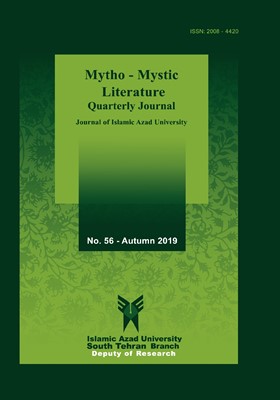The Discourse of Mythological Resistance in the Story of Siāvash; A Semantic and Semiotic Analysis
Subject Areas : Mytho
1 - The Assistant Professor of Persian Language and Literature, Kosar University of Bojnord
Keywords: Resistance, Myth, Tolerance, phenomenology, Siāvash,
Abstract :
In mythological resistance, a centralized presence with an internal power is formed and subject acts as a discursive actor. Siāvash, as a subject and discursive actor, is one of the central characters of Shāhnāmeh who has achieved an internal power. He presents a coherent and transcendental image of the "centralized presence". This presence places the subject as the symbol of identity in the center of discourse. The rival subject adjusts his presence in relation to Siāvash and involves in a mutual interaction or a challenging relationship with him. This confrontation and interaction between them appears in the form of two macro-narratives of resistance and tolerance. The main question is "how the discourse of mythological resistance and consequently, the discourses of resistance and tolerance have been realized in the story of Siāvash". In fact, the purpose of the present research is to examine the method of realization of the discourse of resistance semantically and semiotically, and its impact on the formation of identity and value. Based on descriptive-analytical method, in the present article the attempt is made to show that the subject (Siāvash) defends fulfilling contracts and righteousness by using the techniques of the mythological resistance. On the other hand, the rival subject stands in front of him and forces him to obey, but the subject resists.
بابک معین، مرتضی. 1394. معنا به مثابۀ تجربۀ زیسته: گذر از نشانهشناسی کلاسیک به نشانهشناسی با دورنمای پدیدارشناختی. با مقدمۀ اریک لاندوفسکی. تهران: سخن.
ـــــــــــــــــــــ. 1396. ابعاد گمشدۀ معنا در نشانهشناسی روایی کلاسیک؛ نظام معنایی تطبیق یا رقص در تعامل. تهران: علمی و فرهنگی.
جوکار، منوچهر، قدرت قاسمیپور و عماد بدیلی. 1397. «تحلیل نشانه ـ معناشناختی کارکردهای گفتمانی مقاومت و مماشات در اعترافات تاجالسلطنه». دو ماهنامة علمی ـ پژوهشی جستارهای زبانی. د 9. ش1 (پیاپی43). صص56- 31.
چهارمحالی، محمد، مریم شعبانزاده و محمود حسنآبادی. 1396. «ساختار تقابلی داستان سیاوش در شاهنامه بر اساس نظریۀ لوی استروس». فصلنامۀ ادبیات عرفانی و اسطورهشناختی دانشگاه آزاد اسلامی واحد تهران جنوب. س13. ش49. صص107- 75.
خراسانی، فهیمه، غلامحسین غلامحسینزاده و حمیدرضا شعیری. 1394. «بررسی نظام گفتمانی شوشی در داستان سیاوش». فصلنامۀ پژوهشهای ادبی. س12. ش48. صص54- 35.
رویانی، وحید و منصور حاتمینژاد. 1394. «سیاوش و اسطورۀ بازگشت جاودانه». فصلنامۀ ادبیات عرفانی و اسطورهشناختی دانشگاه آزاد اسلامی واحد تهران جنوب. س11. ش40. صص 261- 239.
سرکاراتی، بهمن. 1385. سایههای شکار شده. تهران: طهوری.
شعیری، حمیدرضا. 1395. نشانه ـ معناشناسی ادبیات: نظریه و روش تحلیل گفتمان ادبی. تهران: دانشگاه تربیت مدرس.
ـــــــــــــــــــــ . 1394. «مقاومت، ممارست و مماشات گفتمانی: قلمروهای گفتمان و کارکردهای نشانه ـ معناشناختی آن». مجلة جامعهشناسی ایران. دوره16. ش1. صص128- 110.
ـــــــــــــــــــــ . 1392. نشانه ـ معناشناسی دیداری. تهران: سخن.
شعیری، حمیدرضا و ابراهیم کنعانی. 1394. «نشانه ـ معناشناسی هستی محور: از برهم کنشی تا استعلا براساس گفتمان رومیان و چینیان مولانا». دوماهنامة علمی ـ پژوهشی جستارهای زبانی. دوره 6. ش 2 (پیاپی23). صص195- 173.
شعیری، حمیدرضا و ترانه وفایی. 1388. راهی به نشانه ـ معناشناسی سیال: با بررسی موردی "ققنوس" نیما. تهران: علمی و فرهنگی.
فردوسی، ابوالقاسم. 1383. شاهنامه (بر اساس نسخۀ چاپ مسکو). به کوشش سعید حمیدیان. تهران: قطره.
کنعانی، ابراهیم. 1396. «بررسی نظام مقاومتی گفتمان در اهل غرق منیرو روانیپور». دوماهنامة علمی ـ پژوهشی جستارهای زبانی. دوره 8. ش6 (پیاپی41). صص326- 301.
نامور مطلق، بهمن. 1392. درآمدی بر اسطورهشناسی: نظریهها و کاربردها. تهران: سخن.
ـــــــــــــــــــــ . 1393. اسطوره متن بینانشانهای: حضور شاهنامه در هنر ایران. تهران: علمی- فرهنگی.
English Sources
Fontanille J. 2008. "Pratique et éthique: la théorie du lien", in Protée, Year 36, no 2, Protee:Université du Québec ά Chicoutimi.
_||_English Sources
Fontanille J. 2008. "Pratique et éthique: la théorie du lien", in Protée, Year 36, no 2, Protee:Université du Québec ά Chicoutimi.
Bābak Mo’īn, Mortezā. (2015/1394SH). Ma’nā be masābe-ye tajrebe-ye zīste: gozar az nešāne-šenāsī-ye kelāsīk be
nešāne-šenāsī bā dūr-namā-ye padīdār-šenāxtī. Tehrān: Soxan.
__________________. (2017/1396SH). Ab’ād-e gomšode-ye ma’nā dar nešāne-šenāsī-ye revāyī-ye kelāsīk; nwzām-e ma’nāyī-ye tatbīq yā raqs dar ta’āmol. Tehrān: Elmī va Farhangī.
Čāhārmahālī, Mohammad and Maryam Ša’bānzāde and Mahmūd Hasanābādī. (2017/1396SH). “Sāxtār-e taqābolī-ye dāstān-e sīyāvaš dar šāhnāme bar asās-e nazarīye-ye Levi Strauss”. Quarterly Journal of Mytho-Mystic Literature. Islamic Azad University- South Tehrān Branch. Year.13. No. 49 .Pp. 75-107.
Ferdowsī, Abolqāsem. (2004/1383SH). Šāhnāme. With the Effort of Sa’īd Hamīdīyān. Tehrān: Qatre.
Jowkār, Manūčehr and Qodrat Qāsemīpūr and Emād Badīlī. (2018/1397SH). “Tahlīl-e nešāne-ma’nā-šenāxtī-ye kārkard-hā-ye goftemānī-ye moqāvemat va momāšāt dar e’terāfāt-e tājossaltane”. Jostār-hā-ye Zabānī. Year 9. No. 1 .Pp. 31-56.
Kan’ānī, Ebrāhīm. (2017/1396SH). “Barresī-ye nezām-e moqāvematī-ye goftemān dar ahl-e qarq-e monīrū ravānīpūr”. Jostār-hā-ye Zabānī. Year 8. No. 6. Pp. 301-326.
Nāmvar Motlaq, Bahman. (2013/1392SH). Daāmadī bar ostūre-šenāsī: nazarīye-hā va kārbord-hā. Tehrān: Soxan.
____________________. (2014/1393SH). Ostūre-ye matn-e beynānešāne-yī: hozūr-e šāhnāme dar honar-e īrān. Tehrān: Elmī va Farhangī.
Rūyānī, Vahīd and Mansūr Hātamīnežād. (2015/1394SH). “Sīyāvaš va ostūre-ye bāzgašt-e jāvdāne”. Quarterly Journal of Mytho-Mystic Literature. Islamic Azad University- South Tehrān Branch. Year 11. No. 40 .Pp. 239-261.
Sarkārātī, Bahman. (2006/1385SH). Sāye-hā-ye šekār-šode. Tehrān: Tahūrī.
Ša’īrī, Hamīd Rezā. (2016/1395SH). Nešāne-ma’nā-šenāsī-ye adabīyāt: Nazarīye va raveš-e tahlīl-e goftemān-e rūmīyān va čīnīyān-e mowlāna. Tehrān: Tarbīyat Modarres University.
________________. (2015/1394SH). “Moqāvemat, momāresat va momāšāt-e goftemānī: qalamrow-hā-ye goftemān va kārkard-hā-ye Nešāne-ma’nā-šenāsxtī-ye ān”. Jame’e-šenāsī-ye Īrān. Year 16. No. 1. Pp. 110-128.
________________. (2013/1392SH). Nešāne-ma’nā-šenāsī-ye dīdārī. Tehrān: Soxan.
Ša’īrī, Hamīd Rezā and Ebrāhīm Kan’ānī. (2015/1394SH). “Nešāne-ma’nā-šenāsī-ye hastī-mehvar: az barham-konešī tā este’lā bar asās-e goftemān-e rūmīyān va čīnīyān-e mowlāna”. Jostār-hā-ye Zabānī. Year 6. No. 2 . Pp. 173-195.
Ša’īrī, Hamīd Rezā and Tarāne Vafāyī. (2009/1388SH). Rāhī be nešāne-ma’nā-šenāsī-ye sayyāl: bā barresī-ye mowredī-ye qoqnūs-e nīmā. Tehrān: Elmī va Farhangī.
Xorāsānī, Fahīme and Qolām Hossein Qolāmhosseinzāde and Hamīd Rezā Ša’īrī. (2015/1394SH). “Barresī-ye nezām-e goftemānī-ye šūšī dar dāstān-e sīyāvaš”. Pažūheš-hā-ye Adabī. Year 12. No. 48 .Pp. 35-54.


